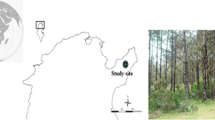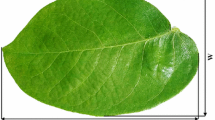Abstract
A total of 660 individual plants ofMalva parviflora, a medicinal plant in many countries, growing in two bioclimatic regions were randomly collected with the aim of examining the differences in the allometry of this herbaceous plant growing in two bioclimatic regions. Allometric relationships were found in plant height, stem width, leaf area, leaf length, leaf width, petiole length, and leaf dry weight whereas no relationship was found between plant height or petiole length with specific leaf area. Plants growing in the cool bioclimatic region showed that plant height increases more than the increase in stem width, leaf length, leaf width, and petiole length while plants growing in the warm bioclimatic region showed that plant height increase was lower than that of stem width, leaf length, leaf width, and petiole length. Plant height relationship with root length indicated that in the cool region the plant height increase was less than the increase in the root length while the opposite occurred in the warm region. These differences can be explained by the effects of the different environmental conditions present in the two bioclimatic regions such as water scarcity and availability on the growth ofM. parviflora.
Similar content being viewed by others
Literature cited
Al-Eisawi D (1996) Vegetation of Jordan. UNESCO, Cairo Office
Bonser ST, Aarssen LW (2001) Allometry and plasticity of meristem allocation throughout development inArabidopsis thaliana. J Ecol89: 72–79
Brouat C, McKey D (2001) Leaf-stem allometry, hollow stems, and the evolution of caulinary domatia in myrmecophytes. New Phytol151: 391–406
Cao K, Ohikubo T (1998) Allometry, root/shoot ratio and architecture in understory saplings of deciduous dicotyledonous tree in central Japan. Ecol Res13: 217–227
Chang J, Guan B, Ge Y, Chan Y (2004) Comparative studies on phynotypic plasticity of two herbs,Changium smyrniodes andAnthriscus sylvestris. J Zhejiang Univ Sci5: 656–662
Cornelissen J (1999) A triangular relationship between leaf size and seed size among woody species: allometry, ontogeny, ecology, and taxonomy. Oecologia118: 248- 255
Henry HA, Thomas SC (2002) Interactive effects of lateral shade and wind on stem allometry, biomass allocation, and mechanica stability inAbutilon thoephrasti (Malvaceae). Amer J Bot89: 1609–1615
Huber H, Lukacs S, Watson MA (1999) Spatial structure of stoloniferous herbs: an interplay between structural blue-print, ontogeny and phenotypic plasticity. Plant Ecol141: 107–115
Huber H, Stuefer JF (1997) Shade-induced changes in the branching pattern of a stoloniferous herb: functional response or allometric effect? Oecologia110: 478–486
Kume A, Ino Y (2000) Differences in shoot size and allometry between two evergreen broad-leaved shrubs,Aucuba japonica varieties in two contrasting snowfall habitats. J Plant Res113: 353–363
Nagashima H, Terashima I (1995) Relationships between height, diameter and weight distributions ofChenopodium album plants in stands: effects of dimension and allometry. Annals Bot75: 181–188
Saad S, Al-Qadi A, Saleh A (1988) Medicinal, aromatic and toxic plants in Arab countries (in Arabic). Arabic organization of Agricultural Development. Khartoum, Sudan, pp 164–165
Sack I, Grubb PJ, Maranon T (2003) The functional morphology of juvenile tolerant of strong summer drought in shaded forest understories in southern Spain. Plant Ecol168: 139–163
Schenk HJ, Jackson RB (2002) Rooting depths, lateral root spreads and below-ground/above-ground allometries of plants in water-limited ecosystems. J Ecol90: 480–494
Shipley B, Meziane D (2002) The balanced-growth hypothesis and allometry of leaf and root biomass allocation. Functional Ecol16: 326–331
Stamp N, Bradfield S, Li S, Alexander B (2004) Effect of competition on plant allometry and defense. American Midland Naturalist151: 50–64
Verwijst T, Wen D (1996) Leaf allometry ofSalix viminalis during the first growing season. Tree Physiol16: 655–660
Weiner J, Fishman L (1994) Competition and allometry inKochia scopaha. Annals Bot73: 263–271
Zohary M (1972) Flora Palaestina. Vol 2. The Israel Academy of Sciences and Humanities, Jerusalem, pp 315–318
Zohary M (1973) Ceobotanical foundation of the Middle East. Swets and Zeitlinger, Amsterdam, pp 262
Author information
Authors and Affiliations
Corresponding author
Rights and permissions
About this article
Cite this article
Eideh, R.A., Elkarmi, A. Allometric relationships ofmalva parviflora growing in two different bioclimatic regions. J. Plant Biol. 48, 319–325 (2005). https://doi.org/10.1007/BF03030529
Received:
Accepted:
Issue Date:
DOI: https://doi.org/10.1007/BF03030529




